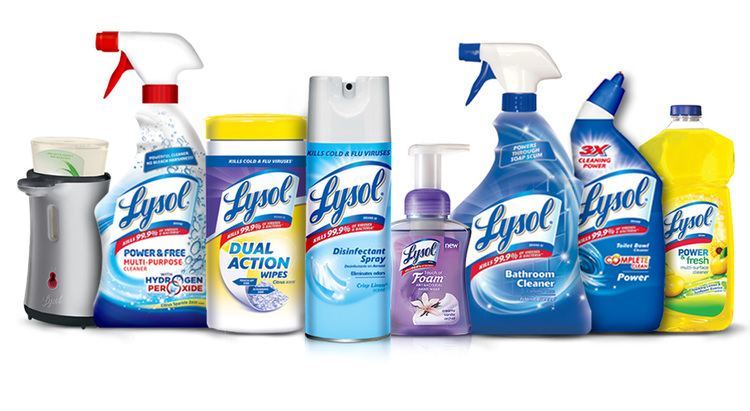Owner Reckitt Benckiser Markets Worldwide | Country U.S. | |
 | ||
Product type Disinfectant, all-purpose cleaners Introduced 1889; 128 years ago (1889) Previous owners Lehn & Fink (later subsidiary of Sterling Drug) | ||
Lysol (/ˈlaɪsɒl/ LYE-sol) is a brand name of cleaning and disinfecting products distributed by Reckitt Benckiser. The line includes solutions for hard and soft surfaces, air treatment, and hand washing. The active ingredient in many of the Lysol products is benzalkonium chloride. The active ingredient in the Lysol Power and Free line is hydrogen peroxide. Scents from Lysol include Crisp Linen, Floral, Fruit & Citrus, Gourmand, and Fresh.
Contents
History
The first Lysol Brand Antiseptic Disinfectant was introduced in 1889 by Dr. Gustav Raupenstrauch to help end a cholera epidemic in Germany. The original formulation of Lysol contained cresols. This formulation may still be available commercially in some parts of the world. Formulations containing chlorophenol are still available in the United Kingdom.
In 1911, poisoning by drinking Lysol was the most common means of suicide in Australia. One of the active ingredients, benzalkonium chloride, is highly toxic to fish (LC50 = 280 μg ai/L), very highly toxic to aquatic invertebrates (LC50 = 5.9 μg ai/L), moderately toxic to birds (LD50 = 136 mg/kg-bw), and slightly toxic ("safe") to mammals (LD50 = 430 mg/kg-bw).
For Spanish flu
In 1918, during the Spanish flu pandemic, Lehn & Fink, Inc. advertised Lysol disinfectant as an effective countermeasure to the influenza virus. Newspaper ads provided tips for preventing the spread of the disease, including washing sick-rooms and everything that came in contact with patients with Lysol. A small (US50¢) bottle made five gallons (19 liters) of disinfectant solution, and a smaller (US25¢) bottle 2 gallons (7.5 liters). The company also advertised the "unrefined" Lysol F. & F. (Farm & Factory) for use in factories and other large buildings – a 5-gallon (19 liters) can, when diluted as directed, made 50 gallons of disinfecting solution.
As a feminine hygiene product
In the late 1920s Lysol disinfectant began being marketed by maker Lysol, Incorporated and distributor Lehn & Fink, Inc. as a feminine hygiene product. It was claimed vaginal douching with a diluted Lysol solution prevented infections and vaginal odor, and thereby preserved youth and marital bliss. This Lysol solution was also used as a birth control agent, as post-coital douching was a popular method of preventing pregnancy at that time. The use of Lysol was later discouraged by the medical community as it tended to eliminate the bacteria normal to the healthy vagina, thus allowing more robust, health-threatening bacteria to thrive, and may have masked more serious problems that certain odors indicated in the first place. All the same, Joseph De Lee, a prominent American obstetrician who held great sway over American obstetric practice through his writings, encouraged the use of Lysol during labor. He writes in 1938, "...[J]ust before introducing the hand, the vagina is liberally flushed with 1 per cent lysol solution squeezed from pledgets of cotton, the idea being to reduce the amount of infectious matter unavoidably carried into the puerperal wounds and up into the uterus by the manipulations."
The Smithsonian Institution in 2013 included the Lysol feminine hygiene ads among others which were "hilarious and shocking" in hindsight.
Product innovations
Ownership: Lehn & Fink was acquired by Sterling Drug in 1967 and Reckitt & Colman acquired L&F in 1994 when Bayer acquired Sterling-Winthrop. As of 2015 Lysol products are distributed by Reckitt Benckiser LLC of Parsippany, New Jersey.
Ingredients
Different Lysol products contain different active ingredients. Examples of active ingredients used in Lysol products:
and Lysol aerosol
Products
Partners
Lysol partners with a variety of organizations as part of the Mission for Health campaign, including:
